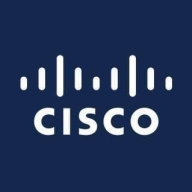



Find out what your peers are saying about Fortinet, Netgate, OPNsense and others in Firewalls.
Clients are now comfortable and not wasting productive hours on IT support.
The automation part is giving us a cost benefit and speed; we can react faster.
It's a very useful tool to mitigate and protect your enterprise.
The biggest return on investment when using Cisco Secure Firewall is that there's no waste in any infrastructure cost and licensing costs for us.
From my point of view, the biggest return on investment when using Cisco Secure Firewall is the single pane of glass, which is a huge plus for us.
The biggest return on investment for me when using Cisco Secure Firewall is reliability and robust network design.
Their user-friendly interface and Panorama central management, which provides a comprehensive overview, make them an ideal investment.
The solution helped reduce downtime, which is crucial in time-sensitive industries like manufacturing.
I have seen a return on investment since using Palo Alto Networks NG Firewalls in terms of time saved.
The graphical interface of Sophos XG simplifies configurations, saving time in support and troubleshooting compared to the Linux-based solution I previously used.
We purchased endpoint security for the first time last year, and even without endpoint security, it provides comprehensive security.
It's good, but I would still say it's higher by about 10-15 percent compared to other market products with similar configurations.
They offer very accurate solutions.
The quick resolution of issues with Fortinet FortiGate is due to the support of the company and the fact that the equipment is easy to work with.
I would rate the technical support for Fortinet FortiGate a ten out of ten.
I have to provide many logs, yet problems remain unresolved, often requiring workarounds rather than solutions.
I have been working with them on firewalls, wireless, switching, and routing, and the support is the best.
They have expertise and provide solutions for the most difficult problems.
Palo Alto's network support is excellent, and I would rate it a ten out of ten.
Their response time is within one hour.
They offer fast and competent assistance.
They are professional, respond quickly, and help resolve issues effectively.
I rate the technical support a ten out of ten.
Their team was quick to diagnose and resolve the problem by exchanging the equipment within two weeks.
They scale up really well from smaller models like the FortiGate 40 and 50 to bigger sites with the FortiGate 100 for more throughput - up to enterprise datacenters.
The variation comes in terms of the interfaces and throughputs, but from a security perspective, you get the same benefit, irrespective of whether you have an entry-level unit or an enterprise.
We determine sizing based on multiple factors: number of users, available links, traffic types, server count, services in use, and whether services will be published.
Scalability presents a challenge.
Compared to FortiGate and Palo Alto, it lags in configuration and other aspects.
Even with the highest one, the 4600, we still face issues, particularly when transitioning between screens; it becomes very slow.
Cloud deployments benefit from auto-scaling, allowing for automatic adjustments to firewall capacity based on demand.
It is important to assess the infrastructure size before choosing a model.
Palo Alto Networks NG Firewalls are scalable and reliable.
You can scale up to multiple firewalls with centralized management.
You can't upgrade memory or storage on a specific model, which limits scalability.
I rate the scalability a nine out of ten.
We're experiencing 99.999% availability consistently.
I would rate the stability of Fortinet FortiGate a ten out of ten.
Currently, we are experiencing a general outage of one of the main internet service providers of the Dominican Republic, and we have not been impacted in our operations because with SD-WAN, we have another internet service provider and we are working with the second WAN connection without any disruption.
We have often encountered split-brain scenarios during failover processes and code upgrades, which have been persistent problems for us.
We work with a cluster with high availability, so if something goes wrong, we have it functioning.
Cisco Secure Firewall offers exceptional performance and stability.
With appropriately configured policies, these firewalls can provide robust network security.
After the upgrade, we are experiencing performance issues.
I have not experienced any outages or issues.
Sophos XG is very stable, even when serving as a DHCP server.
Sophos XG is resource-greedy, affecting performance even on newer computers.
It's on 24/7 and has consistently been reliable over the years.
Investing in a solution that can accommodate such growth would be more cost-effective than repeatedly purchasing new hardware.
While Fortinet claims to offer a comprehensive network solution, it falls short in addressing computer application issues, particularly server security.
When considering Sophos XG, which we also use, the logging and reporting functionality is notably more efficient.
My ongoing complaint for the last six years has been the lack of CLI functionality, which hinders my ability to work on the firewall, alongside concerns regarding deployment time.
Firepower Management Center is quite out of date compared to other vendors.
The integration between Cisco products themselves presents difficulties, such as SD-WAN configuration.
When performance degrades due to full packet inspection, the solution should be to increase the computing power within the same firewall, not to recommend upgrading to a larger, more expensive model.
Further integration into a unified system could improve usability.
Palo Alto Networks NG Firewalls lack built-in multi-factor authentication, requiring the purchase of a third-party tool to implement this essential security feature.
The solution should have the ability to be up to date with the most recent threats.
This suggests a vulnerability that needs addressing to ensure administrators can update patches without losing access.
Business cannot stop just because of issues with support.
Last year, I renewed the support for three years, which can sometimes be expensive but depends on the security benefits and how it helps us.
It offers cost savings as it is generally cheaper than the competition.
It is about 20% cheaper.
It's good to have them, however, it costs us a lot.
It's considered a premium, but people pay that price for Cisco.
There are a lot of in-place contracts for us that provide the benefit of discounts.
Palo Alto Networks NG Firewalls are expensive.
Palo Alto Networks NG Firewalls come at a premium, exceeding the cost of most competitors by 45 percent.
Colleagues looking for the cheapest and fastest firewall can still use Palo Alto Networks NG Firewalls because they are affordable.
I rate the pricing a ten out of ten.
Currently, it costs about four million shillings in Kenya.
The cost depends on the package you are in, such as full threat management or basic.
In terms of security, we have not experienced any security flaws or loopholes, and it has proven to be quite stable.
FortiGate has helped reduce the risk of cyberattacks that might disrupt our client's production.
These features help reduce our downtime, manage the ISPs, and deploy SLAs for all the website traffic.
What stands out positively about Cisco is their training and support, which has effectively prepared engineers to work with their products.
This is very important to my organization, as we work extensively with security because we are a bank, so we can keep the data safe.
Cisco Secure Firewall allows me to safeguard Layer 7 or Layer 3 and manage the security rules with the business needs of my organization.
The most valuable features of Palo Alto Networks NG Firewalls are DNS sync calls, enabled security features, and Wildfire.
Threat Vault allows us access to a comprehensive threat database, enabling us to get detailed information on threats and how to mitigate them.
The most valuable feature of Palo Alto Networks NG Firewalls is Cortex Data Lake.
I particularly like the visibility it provides into network traffic, allowing us to identify and address issues efficiently.
The firewall feature of Sophos XG has been the most effective for threat prevention.
Integration with endpoint security products ensures seamless traffic flow and rule enforcement, even when endpoints are not directly connected to the firewall.
| Product | Market Share (%) |
|---|---|
| Fortinet FortiGate | 20.7% |
| Sophos XG | 9.9% |
| Palo Alto Networks NG Firewalls | 4.1% |
| Cisco Secure Firewall | 6.0% |
| Other | 59.3% |




| Company Size | Count |
|---|---|
| Small Business | 350 |
| Midsize Enterprise | 129 |
| Large Enterprise | 187 |
| Company Size | Count |
|---|---|
| Small Business | 180 |
| Midsize Enterprise | 126 |
| Large Enterprise | 212 |
| Company Size | Count |
|---|---|
| Small Business | 74 |
| Midsize Enterprise | 56 |
| Large Enterprise | 84 |
| Company Size | Count |
|---|---|
| Small Business | 140 |
| Midsize Enterprise | 50 |
| Large Enterprise | 37 |
Fortinet FortiGate excels in providing integrated VPN, firewalling, and Unified Threat Management (UTM) with centralized management and high availability. It supports remote access and comprehensive threat protection, making it a preferred choice for securing networks.
Fortinet FortiGate offers a robust security platform with features such as strong intrusion prevention, application control, and web filtering. Its integration with Active Directory and SD-WAN functionality provides scalable solutions for large networks. Users appreciate its ease of use through centralized management interfaces, ensuring robust security with flexible configurations. However, FortiGate could enhance its graphical interface and technical support responsiveness, address firmware bugs and costly licensing, improve logging, integrate better with third-party tools, and strengthen scalability and memory for log storage. Complexity in configuration and the need for intuitive features are noted challenges, and there's a demand for advanced security, zero-trust capabilities, and AI integration.
What are the key features of Fortinet FortiGate?Fortinet FortiGate is widely implemented across industries like education, finance, and government. Companies use it for firewall protection, VPN, and SD-WAN capabilities, ensuring secure perimeter and data center security. It facilitates remote access management and traffic routing optimization, offering reliable security and connectivity solutions.
Cisco Secure Firewall stands as a robust and adaptable security solution, catering to organizations of all sizes. It's designed to shield networks from a diverse array of cyber threats, such as ransomware, malware, and phishing attacks. Beyond mere protection, it also offers secure access to corporate resources, beneficial for employees, partners, and customers alike. One of its key functions includes network segmentation, which serves to isolate critical assets and minimize the risk of lateral movement within the network.
The core features of Cisco Secure Firewall are multifaceted:
The benefits of deploying Cisco Secure Firewall are substantial. It significantly reduces the risk of cyberattacks, thereby enhancing the security posture of an organization. This security also translates into increased productivity, as secure access means uninterrupted work. Compliance with industry regulations is another advantage, as secure access and network segmentation align with many regulatory standards. Additionally, it helps in reducing IT costs by automating security tasks and simplifying management processes.
In practical scenarios, Cisco Secure Firewall finds diverse applications. It's instrumental in protecting branch offices from cyberattacks, securing remote access for various stakeholders, safeguarding cloud workloads, and segmenting networks to isolate sensitive areas.
User reviews from PeerSpot reflect an overall positive experience with the Cisco Secure Firewall. Users appreciate its ease of configuration, good management capabilities, robust protection, user-friendly interface, and scalability. However, some areas for improvement include better integration capabilities with other vendors, maturity, control over bandwidth for end-users, and addressing software bugs.
In summary, Cisco Secure Firewall is a comprehensive, versatile, and reliable security solution that effectively meets the security needs of various organizations. It offers a balance of advanced protection, user-friendly management, and scalability, making it a valuable asset in the realm of network security.
Palo Alto Networks NG Firewalls deliver advanced threat protection with machine learning, enhancing security through real-time attack prevention. Known for application visibility and a user-friendly interface, they offer robust network protection and flexibility in rule creation.
Palo Alto Networks NG Firewalls are designed to secure environments with features like GlobalProtect VPN, WildFire malware detection, and unified platform integration. Their strong firewall capabilities and high-performance throughput make them suitable for perimeter and data center protection, VPN configurations, application control, and network segmentation. Users consistently highlight the ease of managing network security policies and integrating third-party tools, ensuring a comprehensive protection strategy. While enhancements in support, training resources, and configuration simplicity are needed, these firewalls are integral for securing both on-prem and cloud environments, aligning with platforms like Azure and AWS.
What are the key features of Palo Alto Networks NG Firewalls?Palo Alto Networks NG Firewalls are commonly implemented across industries for securing LAN environments, URL filtering, and ensuring Zero Trust security. They secure both on-premises and cloud infrastructures, often becoming integral parts of security frameworks within enterprises. Leveraging these firewalls in conjunction with Azure or AWS enhances the overall network protection strategies employed by organizations.
Sophos XG provides robust security capabilities, offering features like web filtering, VPN, and user-friendly management. Its intuitive setup and policy adjustments enhance security while synchronized endpoint protection ensures comprehensive defense.
Sophos XG is a network security solution with web and application filtering, VPN features, and a management interface that simplifies configuration. It offers email protection, threat prevention, and reporting capabilities, all contributing to a comprehensive defense strategy. Synchronized security with endpoints enhances protection, and advanced threat protection with efficient bandwidth management supports secure remote work environments. However, users suggest improvements in log interfaces for real-time actions and better email protection. Enhancements in link load balancing, RAM, VPN stability, and central management are needed. HTTPS filtering, certificate management, technical support, and scalability of the SD-WAN feature can see advances.
What are the key features of Sophos XG?In industries such as healthcare, education, and financial services, Sophos XG acts as a mainline defense for network security, VPN connectivity, and web filtering. It supports secure remote access, intrusion prevention, antivirus scanning, and secure web gateways integrated with endpoint systems, tailoring its extensive security capabilities to meet specific industry requirements.